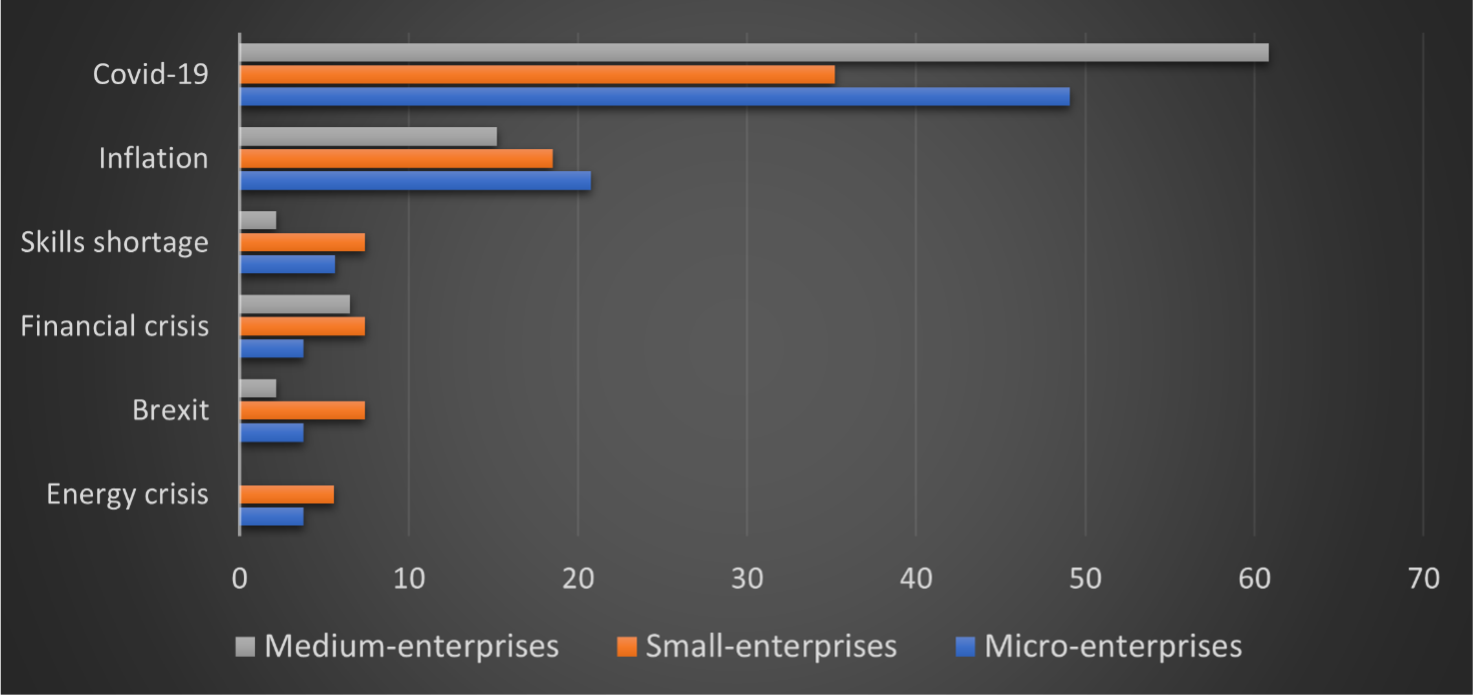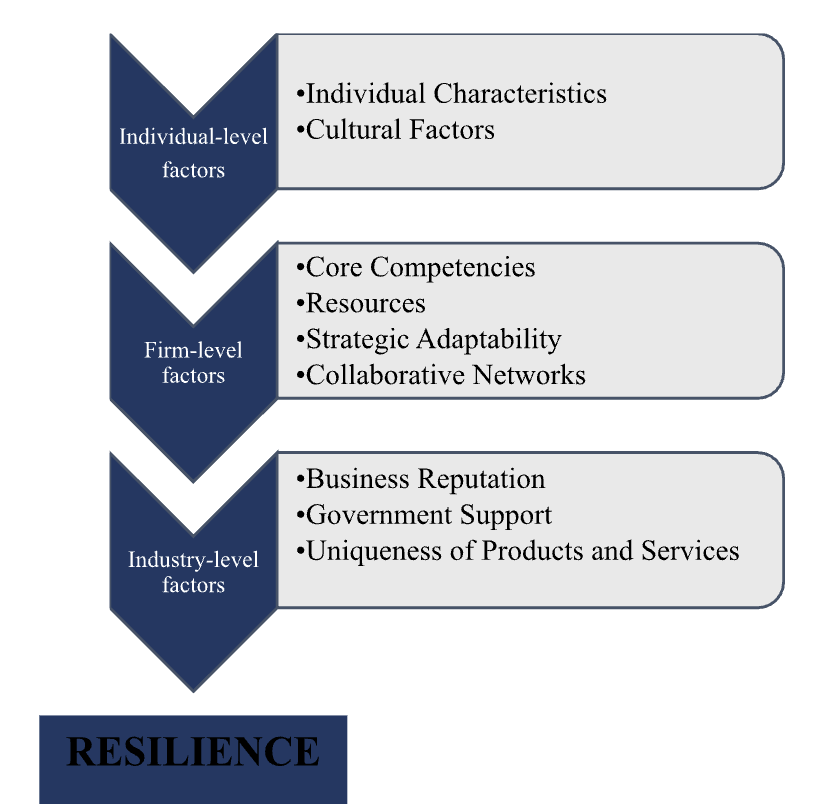California Management Review
California Management Review is a premier academic management journal published at UC Berkeley
by Prasanna Kumar Kukkamala and Nikolina Koporčić

Image Credit | Gajus
Despite their significant contributions to the economy, small and medium-sized enterprises (SMEs) exhibit heightened susceptibility to crises and market disruptions.1 This vulnerability stems from a constellation of factors, including restricted access to capital, limited financial and managerial resources, reliance on a circumscribed customer base, and inadequate preparedness for disruptive events.2 We have recently witnessed many upheavals with their devastating impact on SMEs, such as global financial, energy, and supply chain crises, natural disasters, and wars, among others. For example, the Covid-19 pandemic severely impacted SMEs around the globe.3 According to the McKinsey (2020) report, 70% of SMEs reported a decline in their revenues due to the pandemic.4 The Covid-19 crisis exposed and amplified the chronic resource scarcity faced by SMEs, particularly those operating in contexts marked by significant institutional voids.5 Furthermore, the growing awareness of environmental issues has exerted pressure on businesses to prioritize sustainability and mitigate their environmental impact.6 Moreover, inflation has amplified the burden on SMEs by decreasing the buying ability of customers.7 However, the limited academic attention to SME crisis response leaves practitioners with a crucial knowledge gap when navigating turbulent times.
Liu, W., Beltagui, A., Ye, S., & Williamson, P. (2022). Harnessing exaptation and ecosystem strategy for accelerated innovation: Lessons from the ventilator challenge UK. California Management Review, 64(3), 78-98.
As a part of our research project that explores different crises and their impact on SMEs, we investigated strategic responses to build the resilience of UK SMEs during different turbulent times. These firms comprised micro enterprises, small enterprises, and medium-sized enterprises. The study revealed different factors and attributes that impact the resilience of the firms. We have categorized these factors as individual-level, firm-level, and industry-level factors, based on their origin of emergence. Inspired by these insights, a comprehensive model was developed to understand the emergence of resilience and its multi-level drivers. This framework encompasses three key dimensions, each with distinct elements contributing to strategic responses. This framework seeks to empower business owners and policy makers to consider the multi-level factors that shape the emergence of resilience, ultimately helping them build more resilient SMEs.
In our study of 153 UK SMEs, conducted at the beginning of 2023, the results showed that medium-sized enterprises were the Covid-19 pandemic’s biggest casualty, with a whopping 60.8% suffering negative consequences (see Figure 1). Nearly half of micro-enterprises (49%) also struggled, while small enterprises weathered the storm relatively better, with 35% reporting negative impacts. While inflation impacted businesses of all sizes in the UK, the effect was most pronounced on micro-enterprises, with 20.7% reporting negative impacts, compared to 18.5% of small and 15.2% of medium-sized businesses. The impact of the energy crisis on businesses varied by size, with micro and small enterprises experiencing slightly higher rates of disruption compared to medium-sized enterprises. However, the overall impact across all sizes remained relatively low (see Figure 1). The financial crisis’s impact on businesses varied by size, with 3.7% of micro-enterprises, 7.4% of small enterprises, and 6.5% of medium-sized enterprises reporting some degree of negative impact. Despite a widespread skills shortage, only a small percentage of businesses across all sizes reported feeling its effects. Micro-enterprises (5.6%), small enterprises (7.4%), and medium-sized enterprises (2.1%) were all minimally impacted. Similarly, the impact of Brexit appears to be quite limited, with micro-enterprises (3.7%), small businesses (7.4%), and medium-sized enterprises (2.1%) reporting the lowest percentages.
Overall, the data shows that the Covid-19 pandemic, inflation, and the skills shortage had the most significant impact on SMEs of all sizes, while Brexit, the energy crisis, and the financial crisis have had a relatively small impact.
Figure 1: Impact of different crises on UK SMEs (2023)

After presenting the crises that impacted UK SMEs, we focus on different factors that companies used to successfully navigate the turbulent times.
Responses from micro-enterprises:
We have identified several key factors contributing to the success of micro-enterprises in the UK. Flexibility in business operations and customer targeting were found to be critical factors during crisis times. For instance, price optimization was used to help smooth cash flow into the firm. Some firms adopted this strategy by lowering prices to achieve consistent cash flow even at the cost of lower, albeit temporary, profit margins. Focusing on customer service rather than solely on product selling increases customer loyalty and attracts new clientele. Moreover, strong leadership characteristics, such as commitment and determination, have proved to be key drivers of the resilience of micro-enterprises during challenging times. Some firms highlighted the role of skilled personnel and collaborative partnerships with other firms in accessing valuable knowledge and resources. A firm’s positive reputation was identified as an important factor in attracting both customers and investors. Finally, some firms declare that a well-defined and effective strategy is a foundation for long-term business success.
Responses from small enterprises:
In the face of economic adversity, several small firms have demonstrated remarkable resilience, highlighting their unwavering commitment to continuity. Some managers highlighted strong characteristic features such as perseverance, which persistently helped them to navigate the crisis and run the business smoothly. Due to restrictions on movement and business operations during the Covid-19 pandemic, some firms adopted digital marketing tools, such as social media, to reach broader customer segments and establish strong customer relationships. Moreover, small firms emphasized that cost-control measures have had a positive effect on business success. Some firms attribute the resilience to their smaller size and their focus on debt avoidance, which shields them from the detrimental effects of financial crises. In addition, a strong customer base, built on a steadfast commitment to customer satisfaction, has provided a solid foundation during challenging times. Finally, firms’ cultural dimensions, such as team spirit, their commitment to treating employees as family, supportive work environments, and encouraging creative thinking in employees, have played a significant role in their ability to weather the storms.
Responses from medium-sized enterprises:
Medium-sized firms emphasized the crucial roles of teamwork and adaptability to emerging technologies, including remote work, in navigating the turbulent business landscape. The ability to pivot swiftly and act decisively was also identified as a key factor in overcoming the challenges posed by the Covid-19 pandemic. Some firms highlighted the benefit of dedicated and loyal employees who consistently support the organization during demanding times and play a significant part in the company’s survival and success. Few firms navigated the financial risk with the help of regional government support and business contracts.
In summary, we identified rapid decision making, dedicated staff engagement, and innovative solutions as the cornerstones of success during these unprecedented times.
Based on the research data, we have created a holistic model for building resilient SMEs (see Figure 2) because navigating turbulent times requires more than just weathering the storm. The framework presented next outlines a holistic approach to building business resilience by focusing on three key levels and their factors.
Individual Level: Foundation for Business Resilience
The foundation of organizational resilience is based on a leadership style that values entrepreneurial qualities. This involves taking calculated risks with initiative, engaging decisively if needed, and maintaining a positive attitude during times of difficulty. These qualities enable firms to navigate the crisis by fostering adaptability and resourcefulness. Moreover, fostering a culture of support within the organization serves as a crucial means of stimulating the resilience process. Firms can achieve this by implementing employee-centric practices and support systems. Many firms adopted this strategy during the Covid-19 pandemic, which helped them to increase employee loyalty and trust.
Firm Level: Strategic Agility for Survival
The ability to navigate dynamic business environments through resilience and adaptability is a fundamental prerequisite for firm survival. Our research demonstrates that organizational sustainability is significantly influenced by a firm’s capacity to strategically navigate periods of crisis. In addition, a crisis preparedness plan can contribute to minimizing crisis impact and facilitating rapid recovery. Furthermore, the study highlights the importance of business continuity plans equipped with prevention and recovery systems against potential threats, which can help to create operational resilience. Adapting to evolving market needs can be achieved through strategic business model change, such as swift customer segmentation. Emerging from the Covid-19 pandemic, flexible work arrangements were found to mitigate employee stress and enhance productivity. Moreover, SMEs can mitigate the risk of financial difficulties by implementing efficient cost-control strategies. Strategic agility is further strengthened by embracing innovation and digitalization. Firms can mitigate crisis impact and create customer value through service and product innovation, creating a competitive advantage. Fostering an innovation culture was identified as a key factor in enhancing organizational resilience. Additionally, digitalization and the creation of an online presence facilitate reaching broader customer segments and unlocking new revenue models. Moreover, the results suggest that the development of a collaborative network among diverse stakeholders within a value chain can promote knowledge diffusion and resource pooling and can enhance organizational preparedness and responsiveness during crisis times. Finally, establishing an efficient team equipped to respond rapidly to crises and adapt to change through targeted training programs strengthens overall organizational preparedness.
Figure 2: A holistic model on the representation of factors at different levels of SME resilience

Industry Level: Collective Strength and Support
Industry-level factors, such as business reputation, government support, and uniqueness of products and services can help firms strengthen their resilience. A positive business reputation can significantly draw in and retain stakeholders (investors, customers, and partners) during crisis times. Additionally, government support in the form of grants, tax benefits, training programs, and resource access can significantly bolster SME resilience. Such measures can alleviate financial constraints, enhance operational capabilities, and foster innovation. Furthermore, the distinctiveness of SMEs’ product or service offerings (i.e., product or service differentiation) serves as a critical strategy for establishing a sustainable competitive advantage and differentiating themselves from competitors. This unique value proposition can attract and retain a loyal customer base, even during economic downturns, by offering solutions that are not readily available in the market.
To sum up, this proposed multi-layered framework (Figure 2) emphasizes the complex network of interconnected factors that contribute to an organization’s ability to become resilient in crisis times. At the individual level, the drive and resourcefulness of people lay a crucial foundation for business resilience. This is strengthened by the ability of companies to adjust and prosper in crisis times, providing strategic agility for survival. Finally, the collective strength and support of the industry ecosystem fosters a robust environment that contributes to business continuity and sustained growth in crisis times.
Our findings indicate that on the individual level, managers should pay specific attention to not only their own but also their team members’ personal characteristics, as well as their culture because these features will have an influence on the success of their business during times of crisis.
Action plans involving individual characteristics:
Action plans involving culture:
On the firm level, managers should focus on the factors that will influence organizational preparedness for crisis. Effective crisis response hinges on the capabilities, skills, and strategic actions that pre-exist within an organization. We categorize these firm-level factors into four key areas:
Building crucial competencies:
Mobilize resources:
Embrace strategic adaptability:
Foster collaborative networks:
Finally, in terms of industry-level factors, our findings indicate that unique products and services, business reputation, and governmental support all play a crucial role in shaping the resilience of a business during crisis times.
The uniqueness of products and services:
Reputation capital:
Government support: